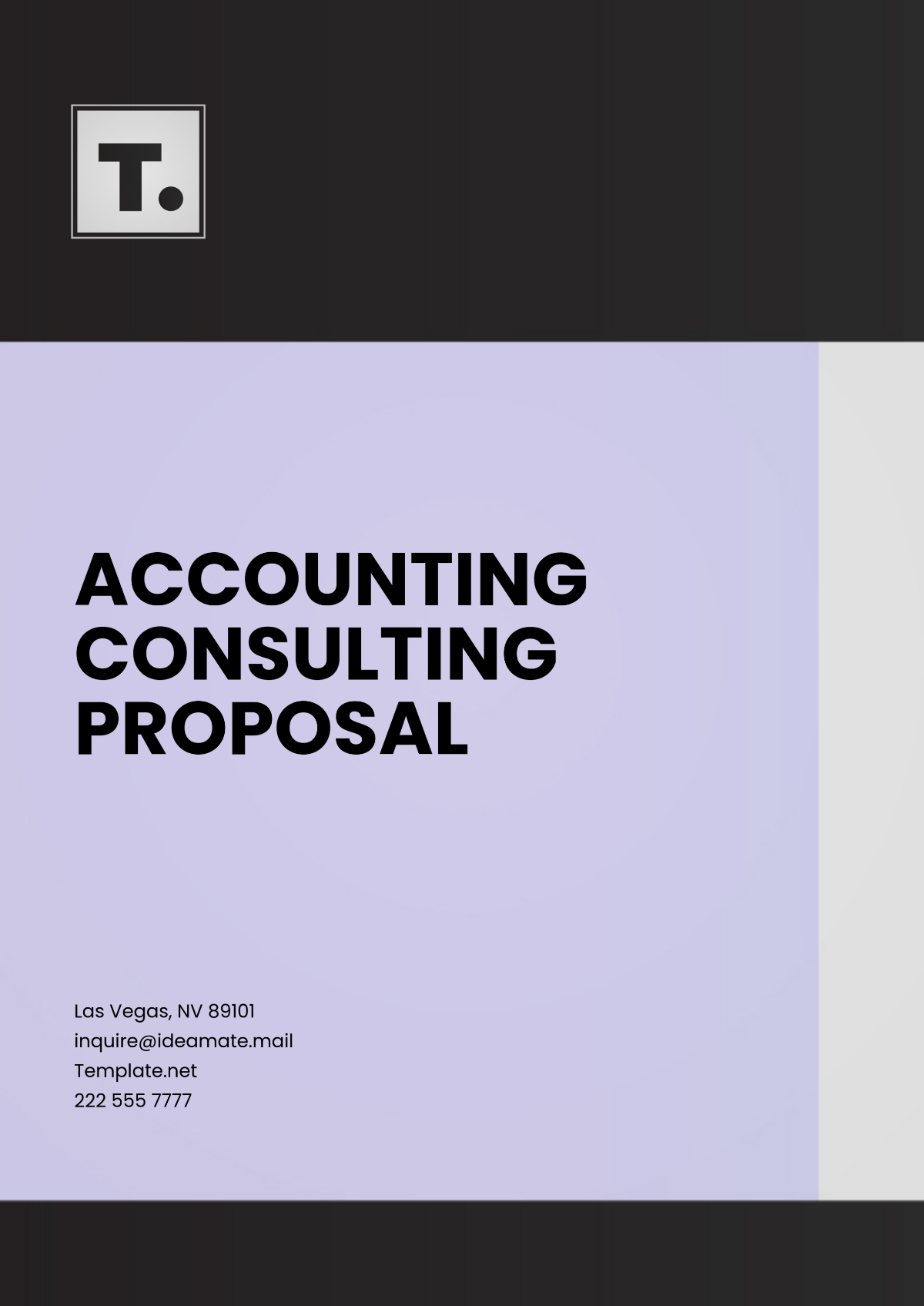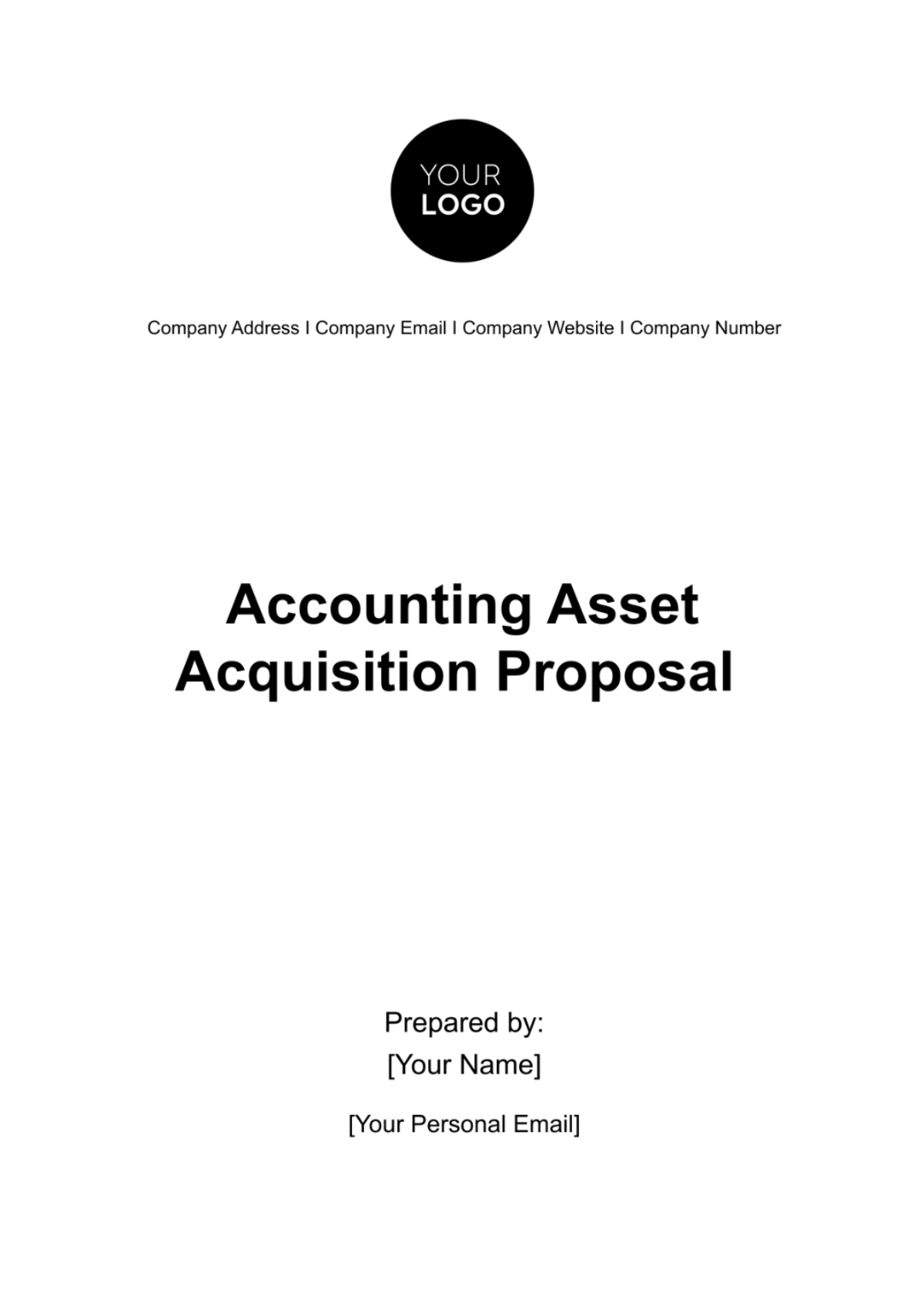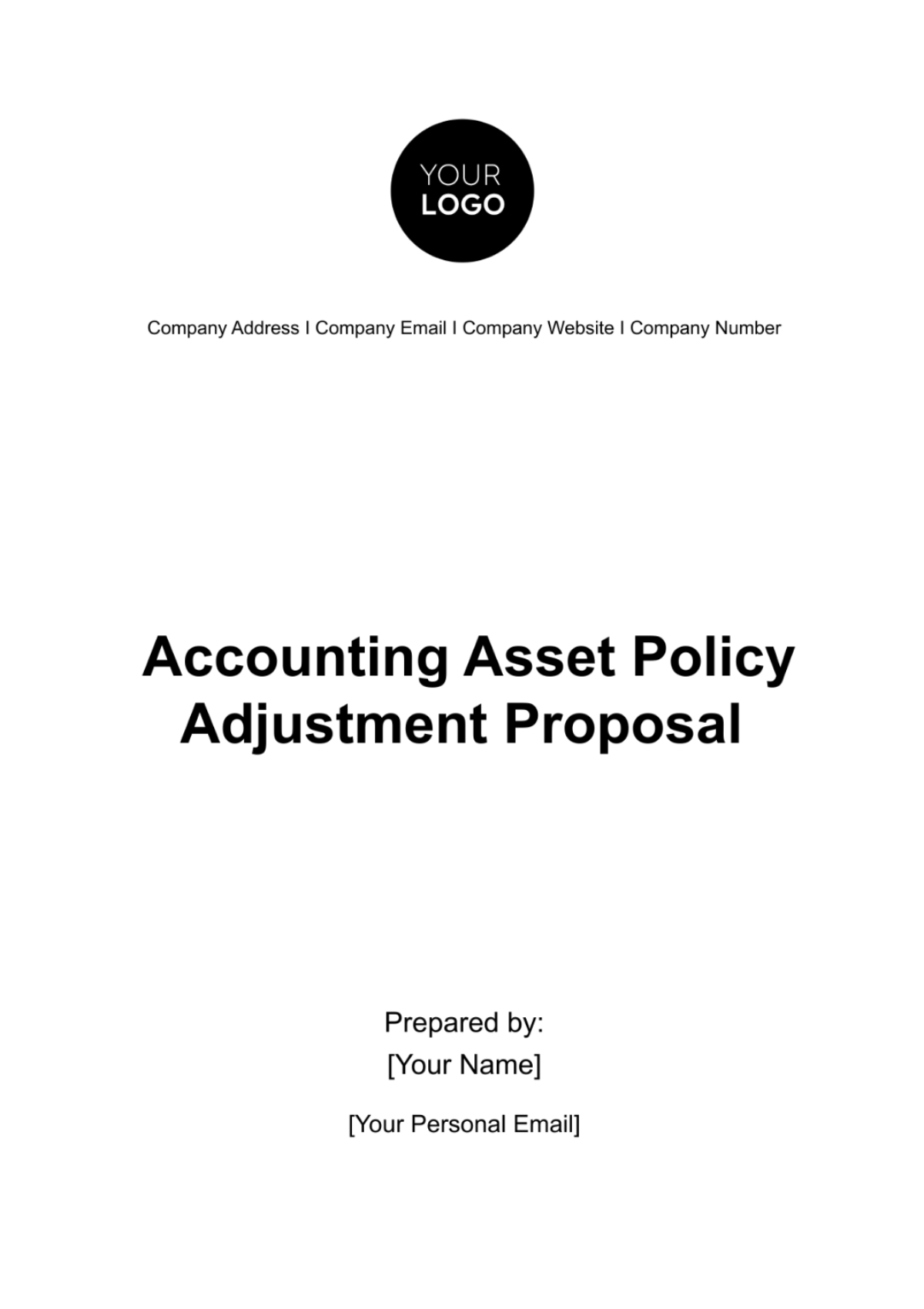Accounting Policy Adjustment Proposal
[Date]
[Recipient Name]
[Recipient Position]
[Company Name]
[Company Address]
[City, State, Zip]
Dear [Recipient Name],
I am writing to propose adjustments to our current accounting policies. These proposed changes are aimed at enhancing the accuracy, transparency, and compliance of our financial reporting processes. As our business landscape continues to evolve, it is imperative that our accounting policies reflect current industry standards and regulatory requirements.
Enclosed is a detailed proposal outlining the suggested adjustments, their rationale, and the anticipated impact on our financial reporting. Our aim is to ensure that [Company Name] remains at the forefront of best practices in financial management.
We believe these changes will not only improve our internal financial processes but also strengthen our reputation for fiscal responsibility and integrity in the eyes of our stakeholders. I look forward to discussing this proposal with you and addressing any questions or concerns you may have.
Thank you for considering these important updates to our accounting policies.
Sincerely,
[Your Name]
[Your Position]
[Company Name]
1. Introduction
This proposal is dedicated to outlining the vital adjustments necessary for the accounting policies currently in use at [Company Name]. In the ever-evolving landscape of business and finance, it is crucial for our accounting practices to be in lockstep with the most recent accounting standards and regulatory requirements. The core objective of this proposal is to ensure the highest degree of accuracy and transparency in our financial reporting. This not only safeguards the company's integrity and compliance with legal and professional standards but also reinforces the trust and confidence of our stakeholders, investors, and the market at large.
The adjustments proposed herein are the result of a thorough analysis of our current accounting practices, taking into account the latest trends in financial reporting, technological advancements, and shifts in regulatory environments. By implementing these changes, [Company Name] will not only enhance its financial accuracy but also position itself as a forward-thinking and compliant entity in the competitive business world.
2. Background
2.1 Current Accounting Policies
Currently, [Company Name] employs a range of accounting policies that have served the needs of the business effectively to date. These policies encompass areas such as revenue recognition, asset valuation, depreciation methods, and expense reporting. However, a detailed review of these policies has identified certain areas where adjustments could lead to more accurate and efficient financial reporting.
For instance, our current depreciation method, primarily straight-line for all assets, may not accurately reflect the usage and wear of certain types of assets. Similarly, the method of revenue recognition in use may need to be updated to align with the latest International Financial Reporting Standards (IFRS) or Generally Accepted Accounting Principles (GAAP), depending on the regulatory framework applicable to our operations.
2.2 Need for Adjustment
The necessity for these adjustments arises from a confluence of factors:
Regulatory Changes: The accounting world is subject to continuous regulatory updates. It is imperative to align our policies with these changes to maintain compliance and avoid potential legal and financial repercussions.
Business Expansion: As [Company Name] grows, diversifies, and enters new markets, the complexity of financial transactions increases. Our accounting policies must be robust enough to accommodate this complexity.
Technological Advancements: The advent of new accounting software and technologies offers opportunities for more efficient and accurate accounting practices. Adapting to these technologies necessitates updates to our existing policies.
Stakeholder Expectations: Maintaining the trust of our investors, clients, and the market requires transparency and adherence to best practices in financial reporting.
3. Proposed Accounting Policy Adjustments
3.1 Summary of Proposed Adjustments
The proposed adjustments are designed to enhance the accuracy, efficiency, and compliance of our financial reporting. These adjustments will be made across various areas of our accounting practices, including but not limited to, depreciation methods, revenue recognition, and asset valuation.
Example: Depreciation Method
Current Policy: Straight-line depreciation for all assets.
Proposed Adjustment: Implementing reducing balance method for certain asset categories.
Reason for Change: To more accurately reflect the usage and wear of assets over time, particularly for those with higher usage in the initial years.
3.2 Detailed Description of Each Adjustment
3.2.1 Depreciation Method Adjustment
Description: This adjustment proposes a shift from a straight-line method of depreciation to a reducing balance method for certain categories of assets. The straight-line method spreads the cost of an asset evenly over its useful life, while the reducing balance method applies a higher depreciation rate in the earlier years of the asset's life, decreasing over time.
Expected Impact: This change is expected to provide a more accurate representation of the asset's value on the balance sheet, leading to a more realistic picture of the company's financial health. It will also impact the profit and loss statements, as depreciation is a key factor in determining net income.
Implementation Plan:
Phase 1: Identify asset categories suitable for the reducing balance method.
Phase 2: Recalculate the depreciation for these assets using the new method.
Phase 3: Update the accounting software and train the relevant staff.
Phase 4: Monitor and review the impact on financial statements for the first fiscal year following implementation.
The implementation of these adjustments will be overseen by the finance department in collaboration with an external accounting firm to ensure accuracy and compliance. Regular reviews will be conducted post-implementation to assess the effectiveness of these changes and to make further adjustments as necessary.
In conclusion, the proposed adjustments to [Company Name]'s accounting policies are a step towards enhanced financial accuracy and regulatory compliance. These changes will not only improve our internal financial processes but also strengthen the company's position in the eyes of our stakeholders and the broader financial community.
4. Timeline
The successful implementation of the proposed accounting policy adjustments is contingent upon a well-structured and meticulously followed timeline. This timeline is designed to ensure a smooth transition, minimizing disruptions to our ongoing operations while effectively integrating the new policies. The following is a detailed breakdown of the activities scheduled over a 12-month period.
Month | Activity |
|---|---|
1-2 | Policies review and gap identification |
3-6 | Policy adjustment and implementation |
7-8 | Training programs |
9-12 | Monitoring and review |
Months 1-2: Policies Review and Gap Identification
Objectives:
Comprehensive Review: Conduct an exhaustive analysis of the current accounting policies against the latest accounting standards, regulatory requirements, and best practices in the industry.
Gap Identification: Identify discrepancies between existing policies and desired standards. This includes pinpointing areas where policies are outdated, insufficient, or non-compliant.
Actions:
Assemble a Review Team: Form a task force comprising members from the finance department, internal audit team, and external consultants (if necessary).
Document Analysis: Examine existing policy documents, financial reports, and process manuals.
Stakeholder Consultation: Engage with key stakeholders, including department heads and external auditors, to gather insights on operational impacts and compliance issues.
Deliverables:
Gap Analysis Report: A document highlighting areas for improvement and recommendations for policy adjustments.
Months 3-6: Policy Adjustment and Implementation
Objectives:
Policy Development: Formulate new or revised policies that address identified gaps, ensuring alignment with business objectives and compliance requirements.
Approval and Documentation: Obtain necessary approvals for the new policies and document them formally.
Actions:
Drafting Policies: Develop new accounting policies or modify existing ones. This includes detailed procedures for implementation.
Review and Approval: Present the draft policies to senior management and the board for review and approval.
Communication: Communicate the approved changes to all relevant departments and stakeholders.
Deliverables:
Updated Policy Manuals: Comprehensive and accessible documentation of all updated accounting policies.
Months 7-8: Training Programs
Objectives:
Ensure Understanding: Guarantee that all staff members understand the new policies and their implications.
Skill Enhancement: Provide training to enhance the skills required to implement the new policies effectively.
Actions:
Develop Training Materials: Create comprehensive training modules that cover the new policies in detail.
Schedule Training Sessions: Organize workshops and training sessions for different departments, focusing on the application of the new policies in day-to-day operations.
External Training: Where necessary, arrange for external training or professional development courses for staff.
Deliverables:
Trained Personnel: A workforce that is well-versed and competent in applying the new accounting policies.
Months 9-12: Monitoring and Review
Objectives:
Ensure Compliance: Regularly monitor the application of the new policies to ensure they are being followed correctly and are effective.
Feedback and Improvement: Gather feedback for continuous improvement.
Actions:
Regular Audits: Conduct periodic audits to assess compliance with the new policies.
Feedback Mechanism: Establish channels for staff to provide feedback on the implementation of the policies.
Review Meetings: Hold quarterly review meetings to discuss the performance of the new policies and identify any areas for refinement.
Deliverables:
Implementation Review Report: A comprehensive report detailing the effectiveness of the new policies, areas of non-compliance, if any, and recommendations for further improvements.
5. Budget
The budget for the proposed accounting policy adjustments is a critical component of the overall plan, ensuring that all phases of the implementation are adequately funded and managed efficiently. The following budget breakdown provides an estimated financial allocation for each major activity in the implementation process.
Item | Estimated Cost |
|---|---|
Review and policy adjustment | $5,000 |
Training | $8,000 |
Monitoring and review | $7,000 |
Review and Policy Adjustment
Estimated Cost: $5,000
Breakdown:
Consultancy Fees: Approximately $3,000 allocated for hiring external accounting experts or consultants to assist in the review and gap analysis phase. This includes their fees for analyzing current policies, benchmarking against industry standards, and providing recommendations.
Internal Resources: Around $2,000 dedicated to internal manpower costs. This covers the time and effort of the internal review team, including finance and audit personnel, in conducting the policy review and drafting new or revised policies.
Training
Estimated Cost: $8,000
Breakdown:
Training Materials: Approximately $2,000 for the development of training materials, including manuals, presentations, and other educational resources.
Workshops and Seminars: Around $4,000 set aside for conducting in-house training sessions. This includes costs for hiring external trainers (if required), venue arrangements (if not conducted in-house), and other logistical expenses.
External Training Programs: An estimated $2,000 allocated for enrolling key finance personnel in specialized external training programs or workshops that provide deeper insights into the new accounting standards and practices.
Monitoring and Review
Estimated Cost: $7,000
Breakdown:
Audit and Compliance Costs: Approximately $4,000 for conducting internal audits to ensure adherence to the new policies. This includes the cost of additional audit resources or external auditors if required.
Feedback Systems: Around $1,000 to establish and maintain feedback mechanisms, such as online surveys or feedback forms, to gather inputs from staff on the implementation process.
Review Meetings: An estimated $2,000 for organizing quarterly review meetings. This covers the costs associated with preparing for these meetings, including data analysis, report generation, and any other administrative expenses.
The total estimated budget for the entire process of adjusting and implementing the new accounting policies stands at $20,000. This budget is designed to cover all essential aspects of the process, from the initial review stage through to the final monitoring and review phase. It is important to note that these figures are estimates and may vary based on actual costs incurred during the implementation. The finance department will closely monitor expenditures against this budget and provide regular updates to ensure effective financial management and accountability throughout the process.
6. Conclusion
This proposal presents a strategic roadmap for refining the accounting policies at [Company Name]. The intention behind these adjustments is to align our accounting practices with the evolving standards and best practices in the financial world. By embracing these changes, we are not only committing to a higher standard of accuracy and transparency in our financial reporting but also demonstrating our dedication to responsible corporate governance.
The implementation of these adjustments is expected to significantly enhance the reliability of our financial statements. This, in turn, will bolster the confidence of our stakeholders, ranging from investors and creditors to employees and customers. Additionally, the alignment with current standards and best practices will position [Company Name] favorably in the market, supporting our long-term business objectives and ensuring sustainable growth.
We understand that change, especially in a critical domain like accounting, requires careful consideration and a collaborative effort. Therefore, we invite feedback and discussions on this proposal to ensure a unified and effective approach to this transition. Your insights and inputs are invaluable as we embark on this journey to refine our accounting practices.
We look forward to your support in this endeavor and are committed to providing all necessary resources and guidance to facilitate a smooth and successful implementation.
Sincerely,
[Your Name]
[Your Position]
[Company Name]
[Date]
Signature:
[Your Name]
[Your Position]
Approval:
[Approval Authority's Name]
[Their Position]
Date:
[Date of Approval]
This proposal, once reviewed and approved, will mark the beginning of a new phase in our financial management practices, one that is more aligned with the best standards in accounting and more responsive to the needs of our dynamic business environment.













